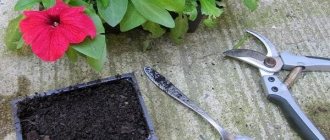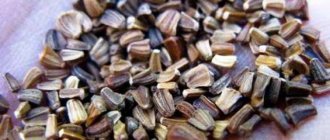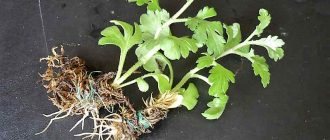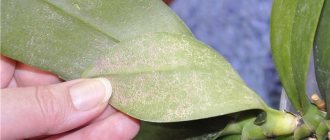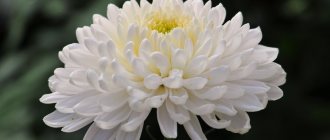In the basement
In regions with harsh winters, spherical multifloras can be dug up and stored in a basement or cellar.
The same method should be preferred when “getting acquainted” with a new variety if you are not sure of its winter hardiness. Preparation for winter is carried out as follows. Before frost sets in, chrysanthemums are dug up, cut to 5-10 cm and, together with a lump of earth, transplanted into a pot or box. If the plant is already growing in a pot, simply prune it. The plants are lowered into the basement with low positive temperatures (2-4°C). The soil on the roots should be moist, but not wet. In winter, you should periodically check the condition of the queen cells and spray the soil when it gets dry.
Closer to February or early March, the chrysanthemum will begin to come to life and shoots will appear. Then it is taken out to a warmer and brighter room, and after the branches have grown, they are cut or divided. Each cutting (or division), subsequently planted in the ground, will give birth to a new flowering ball.
Pruning and replanting
Garden chrysanthemum - planting and growing
After flowering, chrysanthemums are trimmed, leaving only 10 cm of the above-ground part. The action takes place in autumn (October-November).
It is important to know! Multiflora must be replanted carefully, trying not to disturb the structure of the earthen coma, so as not to injure the flower.
Preparing multiflora chrysanthemum for wintering
After autumn pruning, chrysanthemums need preparation for wintering. Bushes overwintering in the ground are covered with spruce branches and covered with humus on top. Chrysanthemums open in spring. This is done gradually so that the multiflora does not get sunburned.
Branbeach Lilac
Period of activity and rest
The plant is dormant in winter. Active vegetation characterizes the period from spring to autumn.
Types and shape of flowers
Multiflora flowers come in a wide variety of colors. As a rule, these are double or semi-double inflorescences. The flowers are medium or small in diameter.
Growing
Caring for cuttings involves spraying them daily and regular watering. Successful rooting is indicated by the appearance of growth on the shoot. Plants can be fed with nitrogen fertilizer. About 1 month after the cuttings begin to root, a root system develops on them. After it becomes powerful enough, new plants are planted in open ground. Most often this happens in May-June.
In the case when rooted shoots cannot be planted in open ground due to the possibility of frost, they are kept in rooms with an air temperature of 8-10 ° C. Under such conditions, “overgrowing” of the cuttings will be prevented. They are planted in a permanent place only after there is no threat of spring frosts. If you do not plan to root the cuttings immediately after cutting, then they are placed in a container with water.
Cuttings of large-flowered chrysanthemums are carried out from January to April, and of small-flowered chrysanthemums - from February to the end of May. Propagation of chrysanthemums in autumn involves planting rooted cuttings in late May and early summer. At the same time, the young bush will bloom early next year.
LiveInternetLiveInternet
Multiflora was not bred for cutting. This species is intended for decorating flower beds, has a distinctly decorative ball shape, and blooms from the end of August until the first snow. Chrysanthemum forms a healthy bush shape only in a sunny place. She is uncomfortable near trees, even in light partial shade. A depressed plant will not be able to form a spectacular ball.
Conventionally, all chrysanthemums can be divided into two groups: large-flowered (Indian) and small-flowered (Korean).
Equated to perennial shrubs. You can grow it both in the garden and on the balcony or even on the windowsill of the house.
This chrysanthemum has the shape of a ball, completely strewn with flowers. The ball is formed from one cutting and does not require pinching to form the spherical shape of the bush, so when planting it is necessary to maintain a distance of at least 50 cm.
Features of growing and caring for dwarf chrysanthemum
Chrysanthemum is unpretentious, it needs your attention and care in winter. At the end of February the plant will begin to grow, don’t miss it. At this time, the flower pot should be moved to a warmer room (on the veranda), where the temperature can be up to 15°C. We take it out, activate watering, and gradually accustom it to sunlight so that the plant does not get burned.
Reproduction
In spring, the bushes are taken to a warm, sunny place, sprayed with water, after which young shoots appear. Then the bush is divided. You can also propagate using cuttings.
The simplest and most common way to propagate chrysanthemums is to grow multiflora chrysanthemums from cuttings. Plant cuttings completely carry all the properties of the mother plant, such as color, shape and size of the bush. It is enough to take a couple of cuttings of the variety you are interested in to grow a new varietal flower for yourself.
Pre-prepare a container for seedlings. A bucket of sand is poured into the bottom of the container. Since chrysanthemums are not picky plants, the sand does not need to be calcined. Then prepare the soil by mixing a bucket of peat, a bucket of soil and half a bucket of sand. Large dried pieces of soil and plant debris are removed. Pour the resulting soil onto a layer of sand in a container, and mulch the surface with calcined sand. The layer of soil for growing cuttings must be at least 12 cm. If you plan to grow only a few plants, the cuttings are rooted in peat tablets or in separate pots.
Multiflora chrysanthemum cuttings are cut from the mother plant starting in March. The size of the finished cutting is 10 cm, the lower leaves are removed. The finished cuttings are kept in the root solution for a day and stuck into the prepared soil at a distance of 8-10 cm from each other. Do not place the cuttings too close, the survival rate of the cuttings is high, and they begin to grow quite quickly. The box with seedlings is kept in a warm room or greenhouse with high humidity for 10-15 days, during which time the cuttings have time to take root. Young plants are planted in separate cups, pots or planted in the ground. Multiflora chrysanthemum seedlings are pinched after 7-8 leaves so that they grow into a beautiful spherical shape.
To propagate chrysanthemums, it is better not to cut them, but to break off the branches. Cuttings can be harvested right up to the moment of flowering. Break off the branch into 2-3 internodes, remove the leaves and top. Plant in wet sand under a jar; the cuttings will take root in about 2-3 weeks. Small shoots can be cut in March (in a tablet or in a pot). In the spring (end of May) we calmly transfer the flowers to the flower beds for further cultivation.
Planting in containers and pots
If the transplant occurs in the reverse order, that is, from the soil to the pot, then it is worth considering some features. As a rule, chrysanthemums are planted in pots either for subsequent sale or to decorate a certain area of the plot or balcony. Transplanting into pots during flowering is carried out only when the third part of the buds opens; in this case, the procedure will not affect flowering. The pot must be at least 25 cm high and 18-25 cm in diameter, only then will the plant’s root system feel comfortable. The size of the pot depends on the vigor of the variety being planted. Any fertile substrate is suitable as potting soil, but not too light, as it dries out quickly.
It is not recommended to keep the chrysanthemum in one place for more than 2 years; it is advisable to divide it and replant it, otherwise it may lose the shape of the bush, i.e. will lose its decorative effect.
Planting in open ground
The place where you plan to plant the plants is chosen to be sunny, since plants grown in the shade do not form the necessary spherical shape of the bush. The site for planting is prepared in the fall; for this, a large amount of humus and ash is added to the soil and dug up. Immediately before planting the plants, the area is dug up again. It is not recommended to grow chrysanthemums for more than 2 years in one place, so the plant is replanted every 3 years.
Young plants grown from cuttings are planted in the ground when favorable conditions occur, starting at the end of April. The distance between bushes is calculated depending on the variety of chrysanthemums and the expected size of the bush. Medium-growing varieties have a ball diameter of up to 50 cm, vigorous varieties - from 50 cm and above. The size of the plant depends not only on the variety, but also on when the cuttings began to be grown. With early March cuttings, the largest bush will grow, but it takes the longest to grow in greenhouse conditions. Cuttings in late April-early May produce the strongest medium-sized bushes. June and later cuttings produce medium or small bushes, some can reach a height of only 20 cm, but despite this, they will still acquire the correct shape during development and bloom.
An adult plant is purchased in a container in the second half of summer. Planted in the ground, or continued to grow in a container, placed in a sunny place. Chrysanthemums tolerate replanting well, but in the summer it is advisable to plant the plant so as not to damage the roots and the formed bush, then it will delight you with beautiful, abundant flowering. When planting, chrysanthemums are watered abundantly.
TIP: Do not add mineral fertilizers when planting.
By doing this you stimulate active growth precisely at the moment when the plant needs rest. Fertilizers will only be needed when planting on poor sandy soils. Be sure to pinch the central sprout after the 8th leaf. If you bought an already blooming chrysanthemum in a pot, planting is carried out using the transshipment method; you should not pinch it. Don't forget to pinch the sprout next year in the spring. When planting, a very effective drainage technique is to add eggshells to the hole. The calcium contained in it will support the growth of the bush during the first 2-3 months, will contribute to its adaptation in the garden, and further active budding.
Care in summer and autumn
In summer, plants are afraid of drought. Multiflora needs to be watered every week, sometimes more often. Some gardeners, when digging before watering, add banana peels to the soil, which contain magnesium beneficial to the plant. Excessive watering can also harm spherical chrysanthemums; it provokes diseases.
During the budding period (June - July), Multiflora will need abundant watering. Plants must be watered only at the roots; sprinkling is not used. During the flowering period, watering is stopped.
TIP: Do not get carried away with applying nitrogen fertilizers, this provokes aphid damage. This is especially true for manure and garden humus.
We apply organic fertilizers, nitrogen, and phosphorus in small doses in the early stages of the growing season, when the buds are just awakening. Phosphorus will help strengthen the root system, nitrogen will stimulate vegetation. Later, fertilizing is carried out with potassium and magnesium fertilizers, which help the plant at the budding stage.
In the fall, do not rush to cut chrysanthemums; the plant needs to form growth points for next year. Wait for the flowers to dry. This means that the plant is ready for winter. Early pruning can interfere with the growth of dormant buds, which is harmful to the plant.
Preparing low-growing spherical chrysanthemum for winter, storing it in winter.
Wintering on the ground
Multiflora is a southern plant, so you definitely need to cover the bushes for the winter (for example, with your own dead wood), or dig up the rhizome, storing it in the basement until spring. To preserve the border flower in open ground (on the ground), in the fall the bush is pruned, shortening it to 15 cm. In October, we mulch the space under the bush with peat, sawdust, and garden humus. Wide layer - 10 cm, don’t be sorry. Cover the root system generously for the winter. And already in November, after the onset of the first cold weather, cover the plant with spruce branches, or your own dead wood, with the cone turned upside down. The result is a ventilated pyramidal shelter. Do not rush to cover the bushes too early to prevent diaper rash and rot. Also keep in mind that these flowers are very afraid of icing. Dried chrysanthemum wood is an excellent covering material that will be useful for gardeners who do not have spruce branches.
How to preserve in winter
The second option is safer; it is better to dig up valuable varieties for the winter. It will overwinter under cover, but the best option would be to store it in a cool room (from + 1 to + 5 °C) in a container with soil. Before the winter period, we cut the bush to a height of 10 - 15 cm and put it in the cellar (underground). The plant will need to be watered every month. Either fill the pot with the plant with sawdust or light soil, slightly moisten the substrate. In winter, periodically check the condition of the bushes. The main enemy of a dwarf flower when stored in a cellar is fungal diseases, rust and powdery mildew.
Dividing the bush
To obtain several new ones from an overgrown adult plant, you can divide the mother bush. To do this, the plant is dug up, its root system is divided into several parts, then the shoots are cut or pinched and planted. When planting, water abundantly and apply organic fertilizers.
This method of propagation is less advantageous compared to cuttings, since it is not always possible to grow a bush of the correct spherical shape from a cutting in the first year. In addition, cuttings allow you to get more new plants per season.
Diseases and pests
Chrysanthemums are susceptible to fungal diseases such as verticillium wilt, powdery mildew, rust, and gray rot. In unfavorable weather conditions or rainy weather, preventive treatment with fungicides against fungal diseases is carried out. The cause of disease is often improper care and excessively thick plantings. If detected early, the disease can be treated.
Sometimes chrysanthemums suffer from mosaic and aspermia. Plants affected by viral diseases must be destroyed and the area treated with formaldehyde. For the next few years, chrysanthemums are not planted in this area to avoid relapse.
Insect pests found on chrysanthemums: mites, caterpillars, slugs, aphids. If insects are detected, the plants are treated with insecticides; against slugs, the ground under the bushes is sprinkled with anti-slug preparations according to the instructions.
Sources: proklumbu.com; dachnaya-zhizn.ru
BEAUTY FOR YOUR GARDEN!!!
Your LYUBASHA BODIA
Dividing the bush.
Chrysanthemums reproduce very well by dividing the bush. Moreover, the bush must be divided every 2-3 years, otherwise the flowers of a thickened bush become smaller and diseases develop more often. And one day in the spring you will discover that the mother bush has disappeared, and this can happen even in a not very severe winter. On the periphery of the bush, one or several dead sprouts may survive, but its center turns out to be bare. And there is only one reason for the death of the bush - regular spring planting of numerous chrysanthemum shoots was not carried out.
Therefore, in the spring, when the return frosts end, you need to carefully dig up the bush and free it a little from the ground.
Then use a sharp pruner to divide the young shoots, immediately plant the shoots with roots in the garden at intervals of 35x35 cm or 40x40 cm and water. You can plant it in the same place, you can plant it in a different place, but you need to plant it somewhat deeper.
How to grow a chrysanthemum from a bouquet?
It happens that a gifted bouquet of chrysanthemums is so beautiful that there is a desire to grow such plants in a pot or in the country and constantly admire the flowers you like. How to be in this case? It turns out that the cutting method is also perfect for propagating cut chrysanthemums from a bouquet. How to do this correctly?
We invite you to familiarize yourself with Greenhouses under film: manufacturing tips
First you need to wait until the chrysanthemums have bloomed, then you should remove the leaves, pinch the top, change the water and wait for the roots to appear. Once the roots have appeared, the plant can be planted. To do this, you need to prepare a suitable place: either in a flowerbed or in a pot, the diameter of which is about 25 centimeters and there are holes for water drainage.
The soil for chrysanthemums should be slightly acidic or neutral; drainage and peat (compost) should be added to it. Plants should be planted in a flowerbed at a distance of about 50 centimeters from each other, and in a pot - one at a time. A couple of times a month you should fertilize chrysanthemums with nitrogen fertilizer. And as the plant grows, you need to pinch the tops of the central shoots to ensure the formation of a beautiful bush.
Do you want to grow many bushes of your favorite chrysanthemums in your garden or on your windowsill? There is nothing simpler: read how to cut chrysanthemums and start making your dream come true.
Step-by-step cutting and rooting technique
For those who are planning to cut a flower they like from a chrysanthemum bouquet for the first time, but have never done this before, there are very simple and understandable instructions for this procedure.
You should not blindly expect that an unpretentious chrysanthemum will be able to easily and quickly root all cut cuttings. In order to grow a truly beautiful and viable flower, you need to carefully select the material for germination and subsequent planting in a pot or flowerbed. An ideal cutting must meet the following requirements:
- the absence of any signs of rot over the entire area of the stem;
- strong and healthy appearance;
- specimens that are too young or too old are not suitable;
- average stem thickness and sufficient rigidity.
For further germination, it is recommended to choose cuttings that have lateral branches, because they can send out roots and multiply faster than others.
Important! Material from weak, diseased or too old chrysanthemum bushes should not be used as cuttings. They either will not be able to produce roots at all, or will rot immediately after planting in open ground.
Selection of chrysanthemum stems for cuttings
The selected planting material is soaked (the lower part) in a solution that stimulates root formation, such as:
- "Epin";
- "Zircon";
- "Kornevin".
The best time for cutting chrysanthemums and then rooting the cuttings is spring, starting from mid-March and ending in late May. The plant enters early flowering in March or April, and late and middle flowering in May.
The stemness and size of the plant's flowers should also be taken into account. Thus, multi-stem chrysanthemums with large and small inflorescences are recommended to be propagated in March, single-stem chrysanthemums - in April-May, and also to be propagated in the first ten days of June
The duration of rooting of cuttings in the first three months of the year is from 20 to 25 days, in warm April or May - about 2 weeks.
Rooted chrysanthemum cuttings
The specific timing of rooting is determined by air temperature (optimally 18-23 degrees) and substrate humidity.
At the very bottom of the pot it is necessary to pour a layer of drainage from bricks ground into crumbs, fine construction sand or expanded clay. This layer will help protect the delicate root system from rot.
The soil for the soil is light, slightly acidic or neutral pH, it is advisable to mix it with a small dose of fertilizer.
Important! The diameter of the pot must be at least 28 centimeters; there must be several holes on the bottom side (on the bottom) to drain excess moisture. Before directly planting the cuttings, it is recommended to thoroughly water the soil to saturate it with moisture.
You should also loosen the soil in the pot and remove all weeds along with the roots.
If you plan to grow a new chrysanthemum bush in a flowerbed, then you should select loose, moisture-permeable and nutrient-rich soil in a sunny and slightly elevated area. In such conditions, the flower will not stretch shoots and bloom at the wrong time.
Cuttings that have successfully completed the rooting stage can be safely planted in a pot or open ground.
In the flowerbed they should not be placed too close to each other, the step is from 0.3 to 0.6 meters. Compact planting is not allowed, otherwise the flowering plant will not develop. The recommended depth of the holes is no more than 1.8 cm. The root system of the chrysanthemum bush grows parallel to the soil, so you should not bury the cuttings too deep into the soil. Around the stem placed in the hole, the substrate is carefully compacted and watered.
Planting cuttings in the ground
Advice. After planting all the material, the surface of the flower bed is spilled with a weak solution of potassium permanganate to disinfect and protect against bacteria.
The seedlings are protected from wind blowing with the help of a fence; it can also be used as a support for thin stems. A few hours after planting, young chrysanthemums may weaken, but with proper care they quickly recover.
On the same day, the growing point of the seedlings is removed; this is called the first pinching. After a few (2-3) weeks, pinching is carried out again, and the apical part of the shoot with a pair of nodules is cut off. This is necessary to form a beautiful bush shape.
For the first few days, it is advisable to shade the planted cuttings with a small canopy for speedy establishment.
How to cut chrysanthemum from a bouquet
How to cut chrysanthemum? How long does it take to root cuttings? When is the best time to start breeding? These questions are of interest to many gardeners who want to grow chrysanthemums in their garden. In fact, propagating these flowers by cuttings is a fairly simple way to get normal and healthy plants, which even novice gardeners can use.
There is also a method of propagating chrysanthemums by sowing seeds. But it does not always live up to expectations, because flowers rarely retain their decorative properties after being grown from seeds.
How to cut chrysanthemums?
The root shoots are cut with a sharp knife under the leaf node when 2-3 internodes are formed on it. The resulting cuttings are planted in boxes or low pots with fertile substrate with a neutral reaction. It is prepared from fertile soil, humus and sand, taken in a ratio of 2:1:0.5. The thickness of the substrate should be 3-4 cm.
To quickly root cuttings, they are treated with a solution of a root formation stimulator. To do this, use the drug “Kornevin” or alpha-naphthylacetic acid (NAA).
The cuttings are buried in the substrate to a depth of 2.5-3 cm. The optimal temperature for rooting cuttings is 18-20 °C. In the room used for rooting cuttings, it is necessary to maintain an optimal microclimate. To do this, a “dome” of polyethylene film is made over the container, providing the necessary air humidity.
Cutting process
It is necessary to distinguish between actually green and actively growing cuttings. The latter take root faster, but require more careful care. They are cut from the tops of young shoots - actively growing parts of the plant on which lignification has not yet begun.
Green cuttings are obtained from the top of young shoots after the spring wave of growth has died down. The stem at this time is already beginning to become lignified. During rooting, such a cutting coarsens even more.
Slicing
Early, mid and late flowering varieties are cut at the same time. Cuttings are cut when at least 4 leaves grow on the shoots. It is not recommended to take weak, fattening or shortened shoots - they will later grow into poorly decorative plants.
Cuttings can be carried out at a later date, using the apical parts of previously rooted young chrysanthemums obtained during winter cuttings.
Rules for cutting cuttings:
- 1The shoots are divided into segments using a cutting board.
- 2The length of the cutting should be 4-5 cm.
- 3Each of them should have two internodes.
- 4 Properly cut cuttings should not have a hard or soft base. In the first case, rooting will be slow, in the second the stem will rot.
- 5C cuttings do not cut off the leaves - they are needed for quick rooting. The lower plates are removed, since after planting they still rot.
1 - cuttings of small-flowered multiflora chrysanthemums, prepared for planting; 2 - rooted cuttings after 20 days
Green cuttings can be cut as soon as there is a decrease in the rate of shoot growth. For open ground chrysanthemums this is the beginning of June. The shoots are cut in the morning, immediately placed in a bucket of water or in a plastic bag and taken into the shade.
Chrysanthemum shoots are fragile and delicate, so to cut them it is better to use a safety razor blade inserted into a special frame so that only one side of the tool is working. The sharp edges of the razor allow you to get perfectly smooth cuts - in this case, rooting proceeds faster. The instrument must be periodically disinfected so as not to transfer viral diseases from one shoot to another.
Timing of cuttings
Chrysanthemum cuttings are carried out from March to the end of May. Large-flowered plants grown in a single-stem culture can be taken from April to early June.
The first cuttings from the mother plant can be obtained as early as March, using shoots emerging from the ground from the roots. Cuttings from shoots that appear on old stems should not be taken.
On the balcony
An excellent method for city residents who bought a multiflora chrysanthemum in a pot. It is good because you can see wintering plants every day and monitor their condition.
Any glazed balcony or loggia or veranda is suitable for wintering. That is, any bright and cool place in which the temperature remains 3-10°C in winter. Moreover, quite wide variations in this range are allowed; nothing bad will happen with a cooling of up to 1°C or with a warming of up to 15°C.
Also, on a balcony or even on a cool windowsill, multiflora can overwinter in the form of cuttings, which need to be rooted in advance - at least in early autumn.
Popular multiflora varieties, what they look like
Garden chrysanthemum - planting and growing
A wide variety of varieties allows each gardener to choose the appropriate option for his garden. And it is unlikely that any amateur gardener will refuse to decorate the site by planting the ideal shape of flowers.
Branbeach White
Despite the name of the flower, it is white only at the tips of the petals. The core of the inflorescence is bright yellow.
The flower is shaped like a pompom. Well suited for creating a composition with bright flowers, as it does not overload the appearance of the bouquet.
Branindio Branindio
The multiflora of this variety has a two-color color: the opened flowers have a yellow tint, and the closed buds appear orange.
The plant reaches a height of no more than 50 cm. Flowering begins in the first half of September.
Branbeach Sunny
The diameter of the bright yellow inflorescences of Branbeach Sunny reaches 6 cm with a small bush size of 30 cm in height.
The plant begins to bloom in the second half of August, seeing off the summer with its brightness.
Branbeach Sunny
Branhill Red
A low, compact, spherical bush dotted with small double flowers of a dark red hue. Their diameter does not exceed 5 cm.
Flowering begins in August.
Branfountain Salmon
Salmon-colored flowers have a more pronounced, muted red core. The diameter of the inflorescences reaches 4 cm. The height of the bush is about 40 cm.
Flowering begins in September.
Branfountain Lemon
The mid-blooming chrysanthemum blooms in early September. The bush reaches a diameter of half a meter. It is completely covered with small inflorescences of a light yellow, lemon shade, which is why it got its name.
Branfountain Purple
Lilac multiflora blooms in mid-September. The exact time most often depends on the weather conditions and climate of the region in which it grows.
The bush measures up to 50 cm in diameter and has beautiful double flowers.
Branbeach Lilac
Chrysanthemum blooming in mid-September. Quite miniature bushes, reaching a height of only 50 cm.
It has fairly large inflorescences, soft purple at the tips of the petals and bright pink around the yellow core.
Branbeach Orange
An early variety of chrysanthemum that blooms buds in the second half of August. The name vividly describes the shade of the inflorescences - a very rich orange. The spherical bushes reach half a meter in diameter.
Branbeach Orange inflorescences
About limited watering of overwintered chrysanthemum mother plants
I would like to draw attention to the common mistake of over-watering, which many gardeners make when they take out multiflora queen cells from the basement in the spring, which are already beginning to germinate.
The mistake is that overwintered chrysanthemum bushes begin to be watered abundantly after storage. This often leads to the death of multiflora due to soaking of the rhizome.
To prevent this from happening, you need to water the mother chrysanthemum bushes only after the soil has completely dried out. And at the same time, do not spill the entire earthen lump, but take literally half a cup of water and splash it over the surface of the substrate in the pot.
We suggest you familiarize yourself with Chest pain
Feeding
In the vegetative growth phase (during the growth of green mass), fertilizing with a predominance of nitrogen (N) is used. For the formation of the root system, cell walls, as well as for better nitrogen absorption, it is recommended to add calcium (Ca) to the nutrient diet. For example, in the form of calcium nitrate, which contains both calcium and the necessary nitrogen.
In the reproductive phase (when the process of laying buds is underway), the composition of fertilizers is changed to phosphorus-potassium.
The interval between feedings is 7-10 days.
Advantages of planting multiflora chrysanthemum seedlings in pots
For those gardeners who have many different flowers growing in their flower beds, including heat-loving summer flowers, the option of planting chrysanthemum multiphora seedlings in pots is very convenient.
Plant multiflora seedlings, one plant at a time, in large pots (3.5-5 liters) with drainage holes at the bottom. Then these pots with spherical chrysanthemum seedlings must BE BURNED into the ground. This will protect the plants in pots from the effects of unfavorable natural factors (from summer overheating, from being knocked over by the wind, etc.).
Planting multiflora chrysanthemum seedlings in pots is convenient and rational for several reasons. Firstly, while the chrysanthemum seedlings are still small and not decorative enough, you can temporarily bury pots with developing bushes, initially not in the front place of the flower beds, but somewhere to the side or in the garden, where the young plants will have space and sun.
Then, closer to autumn, when the multiflora chrysanthemum has already formed a beautiful spherical crown and is completely covered with buds, preparing to bloom, it is time to dig up pots with spectacular plants and move them to a prominent place in the garden. For example, dig flower beds in the foreground instead of fading summer beds. Moreover, moving pots with chrysanthemums to a new place will be completely painless for the flowering bushes.
Secondly, the advantage of planting multiflora seedlings in pots is that for a small pot volume it is not difficult to prepare a nutritious and light substrate with the addition of perlite or vermiculite.
Thirdly, multiflora chrysanthemum bushes growing in pots will not need to be dug up from open ground in the fall and replanted before putting the plants in the basement for the winter. It will be enough just to remove the pots with treated chrysanthemum queen cells from the flower beds and transfer them to the right place.
Propagation of chrysanthemums by cuttings: features
Preparations for cuttings should begin during the flowering period of the plants. At this time, it is necessary to select the bushes that are most suitable for varietal characteristics, which are not affected by pests and diseases, and mark them. In late autumn, almost before frost, these bushes should be dug up without damaging the roots and transplanted into large pots.
We invite you to familiarize yourself with finishing a bathhouse inside or a warm steam room with your own hands: work technology and photos
As soon as the plants have finished flowering, they should be cut off and sent over the winter to a cold room where the temperature does not rise above 6*C. Direct cuttings should be carried out in early spring. For this plant, about a week before cuttings, you need to take it to a warmer room and water it well. They will immediately begin to grow and send out new leaves.
From large-flowered chrysanthemums you can get up to 15 cuttings, and from small-flowered chrysanthemums up to 30. To make the growth of cuttings go faster, you need to constantly water the mother plants and apply fertilizers; organic matter, special liquid fertilizers for flowers, and nitrogen fertilizers, which promote the growth of green mass and the rapid rooting of cuttings, are well suited.
Not all layerings are suitable for cuttings; you need the strongest and highest quality, not too soft stem, but not too hard:
- Weak shoots
- Heavily lignified
- With frequent internodes
- With too thick stem
Variety is different
What is especially interesting is that these chrysanthemums turn into a blooming ball in just a few months - they grow from one small cutting, cut from the mother plant in February-March, without any pinching. The ability to form an ideal spherical habit is genetically inherent in the plant. Moreover, they are more than appropriate in the garden even before flowering, because the “spherical shape” is clearly visible in young chrysanthemums already in July. Well, the plants will show everything they are capable of in September-October.
Read also: Winter garden interior photo
I’ll immediately make a reservation about choosing a multiflora variety for your climate zone. Early varieties, the flowering of which is “scheduled” for the end of August or the very beginning of September, should be bought by residents of central Russia and further north in order to have time to admire the flowering of plants in the ground before the real cold weather. But for the southern regions, medium and late varieties are suitable, because when the early varieties bloom in their zone, they will burn out very quickly in the still active sun and will not show their real color and appearance. And September varieties will delight southerners until November.
Caring for spherical chrysanthemum
During the growth process, the spherical chrysanthemum is very responsive to feeding. At the same time, do not forget to alternate root feeding of chrysanthemums and foliar feeding (spraying on the leaves).
From spring, multiflora chrysanthemum should be fed with complex fertilizers with a predominance of nitrogen, which promotes the formation of a branched, strong bush.
In summer, for better development of chrysanthemums, it is advisable to use complex fertilizers, which, in addition to the main components, contain microelements (for example, “Master”, “Fertika”, “Bona Forte for roses and chrysanthemums”, various humates, etc.).
Closer to the budding period, adult chrysanthemums require phosphorus-potassium fertilizers (for example, potassium humate). By the way, spraying flowering multiflora bushes with a solution of potassium humate gives its flowers a more intense, rich color.
Blooming spherical chrysanthemums
To set buds, chrysanthemums need a short daylight hours - on average, less than 14-12 hours.
To initiate flowering ahead of schedule or even year-round, greenhouse farms use controlled crop technology. This is a complex process associated with the artificial creation of an “autumn” climate. In this case, the main measure is shading chrysanthemums with black film and reducing daylight hours to 9-10 hours.
Similar programming of flowering dates can be applied at home, when growing multiflora chrysanthemums in pots on the balcony.
In addition to short daylight hours, temperature conditions are important for chrysanthemum flowering. The ideal temperature for setting buds is 15-20 °C, for flowering - about 10 °C.
To speed up the flowering of multiflora, you can apply:
Growing problems, diseases and pests
When grown, multiflora may suffer from powdery mildew. In this case, the lower part of the plant becomes bare, and the leaves begin to darken sharply. Then it is necessary to change the top layer of soil and tear off infected shoots, leaves and flowers.
It is also worth spraying the plant with insecticides, which will protect the flower from insects.
Both beginners and professionals can grow multiflora chrysanthemums. Anyone can try to propagate this plant, since no special effort is required for these purposes.
Cuttings of chrysanthemums is the best method of propagation
When growing chrysanthemums from seeds, there is often a loss of their varietal characteristics. The most reliable way to reproduce valuable varieties in large quantities is cuttings. This method is a type of vegetative propagation. The Korean chrysanthemum, which has been popular in recent years, is sometimes propagated by dividing the bush.
“Early” cuttings are those grown in winter (January-February) with short daylight hours. They take root within 1 month. “Late” cuttings obtained in April-May form roots in 1-2 weeks.
